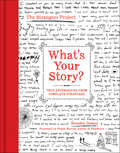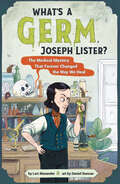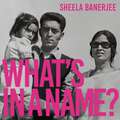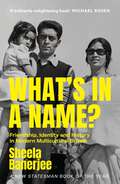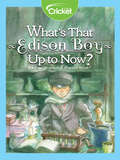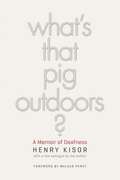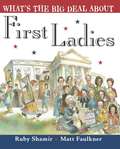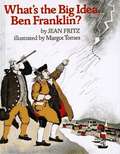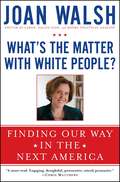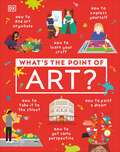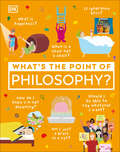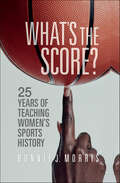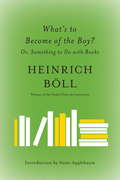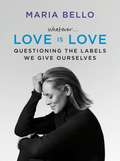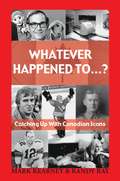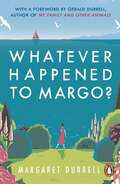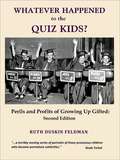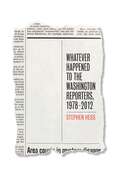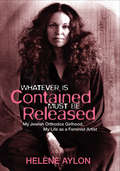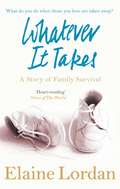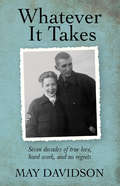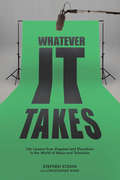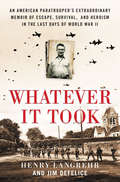- Table View
- List View
What's Your Story?: True Experiences from Complete Strangers (The Strangers Project)
by Brandon DomanEveryone has a story to share. What's yours?In 2009, Brandon Doman, who has always been curious about the people with whom we share our world, sat at a local coffeehouse and decided to ask passersby a simple question: "What's your story?"Providing only paper and pens, Doman created an exploratory space that instantly intrigued people to share their stories anonymously. Now, more than 10,000 stories later, the Strangers Project has become a momentous movement, engaging strangers of all ages and backgrounds to reflect, rejoice, heal, and connect through words.Published here for the first time, What's Your Story? showcases a selection of two hundred stories from the Strangers Project. Equal parts heartbreaking and humorous, this moving compendium lays bare our universal truths, desires, and sufferings, and illustrates the emotional power of storytelling and our shared humanity. To complete this beautiful collage of stories, a blank page is included at the end for readers to add their own personal story.With more than fifty color photographs and illustrations
What's a Germ, Joseph Lister?: The Medical Mystery That Forever Changed the Way We Heal
by Lori AlexanderThis engrossing, timely, and highly illustrated biography of the father of modern surgery reveals the shocking practices of surgeons before Joseph Lister proved where infections come from.In 1841, a quiet, curious boy who stuttered when nervous committed to becoming a surgeon—a profession then more feared than respected.Through study, persistence, and careful research, Joseph Lister proved that unsanitary conditions contribute to infections. Despite others scoffing at his ideas, Lister slowly changed the way all surgeons work, saving countless lives.Sibert Honor-winner Lori Alexander’s accessible and lively biography of Lister contains fun—and sometimes gory—facts about the history of science and engaging illustrations by Daniel Duncan.
What's in Your Pocket?: Collecting Nature's Treasures
by Heather L. MontgomeryCharles Darwin, George Washington Carver, and Jane Goodall were once curious kids with pockets full of treasures!When you find something strange and wonderful, do you put it in your pocket? Meet nine scientists who, as kids, explored the great outdoors and collected "treasures": seedpods, fossils, worms, and more. Observing, sorting, and classifying their finds taught these kids scientific skills--and sometimes led to groundbreaking discoveries. Author Heather Montgomery has all the science flair of a new Bill Nye. Book includes the Heather's tips for responsible collecting.
What's in a Name?: Friendship, Identity and History in Modern Multicultural Britain
by Sheela BanerjeeA sharp and timely examination of Britain's history, through the prism of something intimate and everyday - everyone's name tells a story, no matter how ordinary'Our names reveal a multitude of stories, reveal feelings, states of consciousness and lost histories that embody who we really are and where we come from . . . This is a personal journey to reveal the worlds which gave rise to what we are called'Our names are so mundane that we barely notice them. Yet each contains countless stories of tradition and belonging - be that a legacy of colonialism or persecution, the desire to fit in, or the complex cultural inheritance from one's parents. In What's in a Name?, Sheela Banerjee unravels the personal histories of friends and family through their names. And while tracing their heritage across centuries and continents - from west London to British India, and from 1960s Jamaica to pre-Revolutionary Russia - Sheela also tells the story of twentieth-century immigration to the UK.Blending history, memoir and politics, What's in a Name? is a celebration of Britain's rich multiculturalism, an ode to friendship and a testament to all the stories held within our names.(P)2023 Hodder & Stoughton Limited
What's in a Name?: Friendship, Identity and History in Modern Multicultural Britain
by Sheela Banerjee'A brilliantly enlightening book . . . at times moving, at others ironic, full of insights and detail' Michael RosenOur names are so mundane that we barely notice them. Yet each contains countless stories of tradition and belonging - be that a legacy of colonialism or persecution, the desire to fit in, or the complex cultural inheritance from one's parents. In What's in a Name?, Sheela Banerjee unravels the personal histories of friends and family through their names. And while tracing their heritage across centuries and continents - from west London to British India, and from 1960s Jamaica to pre-Revolutionary Russia - Sheela also tells the story of twentieth-century immigration to the UK.Blending history, memoir and politics, What's in a Name? is a celebration of Britain's rich multiculturalism, an ode to friendship and a testament to all the stories held within our names.
What's that Edison Boy Up to Now?
by Ruth Spencer JohnsonWhen Thomas Edison was a boy, he loved performing experiments and coming up with new inventions. His curiosity sometimes got him in trouble, though, like when he accidentally burned down his dad’s barn! By the time he turned 12, he had found ways to make a living by learning how to print newspapers and send telegraphs in Detroit, Michigan. Imagine what he did as an adult!
What's that pig outdoors?
by Henry KisorHenry Kisor lost his hearing at age three to meningitis and encephalitis but went on to excel in the most verbal of professions as a literary journalist. This new and expanded edition of Kisor's engrossing memoir recounts his life as a deaf person in a hearing world and addresses heartening changes over the last two decades due to the Americans with Disabilities Act of 1990 and advancements in cochlear implants and modes of communication. _x000B_Kisor tells of his parents' drive to raise him as a member of the hearing and speaking world by teaching him effective lip-reading skills at a young age and encouraging him to communicate with his hearing peers. _x000B_Kisor updates the continuing disagreements between those who advocate sign language and those who practice speech and lip-reading, discusses the increased acceptance of deaf people's abilities and idiosyncrasies, and considers technological advancements that have enabled deaf people to communicate with the hearing world on its own terms.
What's the Big Deal About First Ladies
by Ruby Shamir<p>Did you know that Mary Todd Lincoln hated slavery and helped to end it in America? Or that Edith Wilson helped decode secret messages during World War I? How about that Sarah Polk didn’t let anyone dance in the White House while she was first lady? <p>It’s true! In addition to being hostesses, advocates, ambassadors, activists, patriots, and role-models, each first lady put her own stamp on the White House—and on our country. In this fun-filled, fact-filled book, you can find out just what made each first lady unique and why they were so important. As it turns out, first ladies are a pretty big deal after all! </p>
What's the Big Idea, Ben Franklin?
by Jean FritzA brief biography of the eighteenth-century printer, inventor, and statesman who played an influential role in the early history of the United States.
What's the Matter with White People?: Finding Our Way in the Next America
by Joan WalshA CLEAR-EYED, COGENT CLARION CALL FOR ENDING THE DIVISIVE CLASS WARS THAT THREATEN THE AMERICAN MIDDLE-CLASS DREAM In What’s the Matter with White People? Walsh argues that the biggest divide in America today is based not on party or ideology but on two competing explanations for why middle-class stability has been shaken since the 1970s. One side sees an America that has spent the last forty years bankrupting the country by providing benefits for the underachieving, the immoral, and the undeserving—no matter the cost to the majority of Americans. The other side sees an America that has spent the last forty years catering to the wealthy while allowing only a nominal measure of progress for the downtrodden. Using her extended Irish-Catholic working-class family as a case in point and explaining her own political coming-of-age, Walsh shows how liberals unwittingly collaborated in the “us versus them” narrative and how the GOP’s renewed culture war now scapegoats segments of its own white demographic. Part memoir, part political history, What’s the Matter with White People? is essential reading to combat political and cultural polarization and to build a more just and prosperous multiracial America in the years to come. WITH A NEW AFTERWORD
What's the Point of Art? (DK What's the Point of?)
by DKGet your paints and canvases ready for a fun-filled journey through art! Explore how artists get ideas and bring them to life, how art can affect the way we think and feel, and why people throughout history loved it so much.Why is art important? What's so great about it? In this illustrated book, you'll see the world through famous artists' eyes, and what inspired them to make art. And you'll use their techniques to produce your own masterpieces. Did you know that early humans spent a great deal of time on their cave paintings? Before cameras and smartphones were invented, people had paintings and drawings made of them to keep a record of what they looked like. Many artists, such as Vincent Van Gogh and Frida Kahlo, used art as a language to express their feelings, thoughts, and emotions in ways that words couldn't. Explore techniques you can use to create art, and you don't have to be good at drawing and painting to do it. If you want to learn why art has the power to be beautiful, shocking, entertaining, and even political, What's the Point of Art? is the place to start. This book is about how art has changed the world, one artistic movement at a time, and it is guaranteed to inspire, surprise, and entertain everyone who picks it up.
What's the Point of Philosophy? (DK What's the Point of?)
by DKTravel down the road of wisdom to discover how to think about a series of philosophical problems, how to defend your opinions on them, and how to evaluate the opinions of others.Why is philosophy important? What&’s so great about it? Leap into the world of philosophy and discover questions about life, the universe, and human behavior that great thinkers have pondered throughout history, and which are still being asked today.Philosophical ideas affect our day-to-day lives in ways that you might not expect. But understanding these ideas can be daunting – even for adults! If you want to learn how to argue the case for animal rights, why the concept of equality has many sides, or even what the theories are about why humans exist at all, What&’s the Point of Philosophy? is the perfect place to start. Put your thinking cap on and get ready to explore:- A variety of fascinating topics reveal pivotal questions in philosophy that are still discussed today.- Timeline spreads illustrate major schools of thought and the women and men who developed them.- Clear, accessible text makes the book appealing for readers of all ages.- Uncoated paper gives a vintage feel to the book which perfectly complements the illustrator&’s style.This fascinating philosophy book is a unique way to get kids to begin thinking critically about the world around them, and showcases the many ways in which philosophy has changed the world, one crazy idea at a time, and it is guaranteed to inspire, surprise, amuse, and entertain everybody who picks it up. By slowly unraveling arguments to unpack complex theories, What&’s the Point of Philosophy? allows you to connect with ideas in a new and exciting way. If you never stop asking &‘why?&’, this is the book for you!
What's the Score?: 25 Years of Teaching Women's Sports History
by Bonnie J. MorrisWho is the first female athlete you admired? Were male and female athletes treated differently in your high school? Is there a natural limit to women's athletic ability? How has Title IX opened up opportunities for women athletes?Every semester since 1996, Bonnie Morris has encouraged students to confront questions like these in one of the most provocative college courses in America: Athletics and Gender, A History of Women's Sports. What's the Score?, Morris's energetic teaching memoir, is a peek inside that class and features a decades-long dialogue with student athletes about the greater opportunities for women—on the playing field, as coaches, and in sports media. From corsets to segregated schoolyards to the WNBA, we find women athletes the world over conquering unique barriers to success.What's the Score? is not only an insider's look at sports education but also an engaging guide to turning points in women's sports history that everyone should know.
What's to Become of the Boy?
by Heinrich Böll Leila Vennewitz Anne ApplebaumA vivid account of growing up poor, rebellious, and anti-Fascist in Nazi Germany. What's to Become of the Boy? is a spirited, insightful, and wonderfully sympathetic memoir about life during wartime written with the characteristic brilliance by one of the 20th-century's most celebrated authors. It is both an essential autobiography of the Nobel Prizewinning author and a compelling memoir of being young and idealistic during an age of hardship and war.
Whatever . . . Love Is Love: Questioning the Labels We Give Ourselves
by Maria BelloThe acclaimed actress questions the labels we wear when it comes to partnership, career, love, and sexuality in this deeply moving memoir.Written as a series of provocative questions and thoughtful answers, Whatever . . . Love Is Love is filled with deeply personal, often funny, and even passionate stories, stories in which Maria bares her soul and shares what she’s learned—not only about romantic love, but also about her relationship with her parents, her feelings about spirituality, her sexual identity, the highs and lows of her career, her humanitarian work, and her worth as a mother.Using her experiences as a gateway to a larger conversation, Maria encourages you to think about the life you lead, who you love, what you do, what you believe in, and what you call yourself . . . and helps you to realize that the only labels that matter are the ones we place on and accept for ourselves, even if they don’t fit the mold of “typical.”“Whatever . . . Love Is Love isn’t your typical celebrity memoir. . . . Instead, each chapter, through charming candor and humor, challenges a series of ‘labels’ that represent impossible standards to which we hold ourselves.” —Marie Claire“Never preachy, in this book [Bello] diligently and methodically deconstructs where her values have come from. . . . Personal, provocative, and inspiring.” —Patricia Arquette, Oscar®-nominated actor
Whatever Happened To...?: Catching Up with Canadian Icons
by Mark Kearney Randy RayThe latest book by Canada’s Trivia Guys is an entertaining where-are-they-now look at the fate of some 100 celebrities, newsmakers, and significant artifacts from this country’s past. Lake Ontario swimmer Marilyn Bell, CFL legend Russ Jackson, Canada’s first automobile, and Roger Woodward, a boy who survived the waters of Niagara Falls more than 40 years ago, are among those tracked down. Long after making headlines or burrowing their way into our collective consciousness, these Canadian icons have travelled different roads or in some cases kept more quietly to the path that gained them attention in the first place. Kearney and Ray spice up their stories with dozens of fascinating facts. With website links to further information, this book is a great resource to learn more about Canada’s heritage.
Whatever Happened to Margo?
by Margaret DurrellIn 1947, returning to the UK with two young children to support, Margaret Durrell starts a boarding house in Bournemouth. But any hopes of respectability are dashed as the tenants reveal themselves to be a host of eccentrics: from a painter of nudes to a pair of glamorous young nurses whose late-night shifts combined with an ever-revolving roster of gentleman callers leading to a neighbourhood rumour that Margo is running a brothel. Margo's own two sons, Gerry and Nicholas, prove to be every bit as mischievous as their famous Uncle Gerald - and he himself returns periodically with weird and wonderful animals, from marmosets to monkeys, that are quite unsuitable for life in a Bournemouth garden.
Whatever Happened to the Quiz Kids?: Second Edition
by Ruth Duskin Feldman"...a terribly moving series of portraits of those precocious children who became premature celebrities."-- Studs Terkel"...a fascinating look at the lives of child prodigies...a longitudinal study of gifted children that is sincerely told."-- Deborah Earle The Quiz Kids radio and television program was a national institution in the 1940s and 1950s. Ruth and a few other top contestants were guests on the Jack Benny, Fred Allen, and Eddie Cantor shows, starred in movie shorts, and traveled all over the United States selling war bonds during World War II.Did the Quiz Kids fulfill their youthful promise? What were the fruits -- bitter and sweet -- of their childhood experience? What are the lessons for gifted children today? Ruth interviewed her Quiz Kid colleagues to find out how being celebrated for their "brains" affected their lives. The result is Whatever Happened to the Quiz Kids?
Whatever Happened to the Washington Reporters, 1978-2012
by Stephen HessWhatever Happened to the Washington Reporters, 1978-2012, is the first book to comprehensively examine career patterns in American journalism. In 1978 Brookings Senior Fellow Stephen Hess surveyed 450 journalists who were covering national government for U.S. commercial news organizations. His study became the award-winning The Washington Reporters (Brookings, 1981), the first volume in his Newswork series. Now, a generation later, Hess and his team from Brookings and the George Washington University have tracked down 90 percent of the original group, interviewing 283, some as far afield as France, England, Italy, and Australia.What happened to the reporters within their organizations? Did they change jobs? Move from reporter to editor or producer? Jump from one type of medium to another--from print to TV? Did they remain in Washington or go somewhere else? Which ones left journalism? Why? Where did they go?A few of them have become quite famous, including television correspondents Ted Koppel, Sam Donaldson, Brit Hume, Carole Simpson, Judy Woodruff, and Marvin Kalb; some have become editors or publishers of the New York Times, Wall Street Journal, Chicago Tribune, Miami Herald, or Baltimore Sun; some have had substantial careers outside of journalism. Most, however, did not become household names.The book is designed as a series of self-contained essays, each concentrating on one characteristic, such as age, gender, or place of employment, including newspapers, television networks, wire services, and niche publications. The reporters speak for themselves. When all of these lively portraits are analyzed--one by one--the results are surprisingly different from what journalists and sociologists in 1978 had predicted.
Whatever Happened to the Washington Reporters, 1978-2012
by Stephen HessWhatever Happened to the Washington Reporters, 1978-2012, is the first book to comprehensively examine career patterns in American journalism. In 1978 Brookings Senior Fellow Stephen Hess surveyed 450 journalists who were covering national government for U.S. commercial news organizations. His study became the award-winning The Washington Reporters (Brookings, 1981), the first volume in his Newswork series. Now, a generation later, Hess and his team from Brookings and the George Washington University have tracked down 90 percent of the original group, interviewing 283, some as far afield as France, England, Italy, and Australia. What happened to the reporters within their organizations? Did they change jobs? Move from reporter to editor or producer? Jump from one type of medium to another-from print to TV? Did they remain in Washington or go somewhere else? Which ones left journalism? Why? Where did they go? A few of them have become quite famous, including television correspondents Ted Koppel, Sam Donaldson, Brit Hume, Carole Simpson, Judy Woodruff, and Marvin Kalb; some have become editors or publishers of the New York Times, Wall Street Journal, Chicago Tribune, Miami Herald, or Baltimore Sun; some have had substantial careers outside of journalism. Most, however, did not become household names. The book is designed as a series of self-contained essays, each concentrating on one characteristic, such as age, gender, or place of employment, including newspapers, television networks, wire services, and niche publications. The reporters speak for themselves. When all of these lively portraits are analyzed-one by one-the results are surprisingly different from what journalists and sociologists in 1978 had predicted.
Whatever Is Contained Must Be Released: My Jewish Orthodox Girlhood, My Life as a Feminist Artist (Jewish Women Writers Ser.)
by Helène Aylon&‘[A] richly evocative, captivating, and reflective memoir&” of a feminist artist who broke free of the limits placed on her by family, Judaism and society (Publishers Weekly). Growing up an Orthodox Jew in Brooklyn, Helene Aylon spent her Friday nights in a sea of extended family as the Sabbath candles flickered. Passionate about art, she dreamt of escaping the strict, secular world of her youth, but instead married a rabbi and became a mother of two. Then, her world was split apart when her husband was diagnosed with cancer, and Aylon found herself widowed at thirty. Free to explore both her own soul and the changing world around her, Aylon sought a home in the burgeoning environmental art scene of the 1970s—creating transgressive works that explore identity, women&’s bodies, the environment, disarmament, and the notion of God. Finally, she dares to asks of Judaism: Where are the women? With many examples of her work included within, Whatever is Contained &”is an arresting tale of uncommon courage, intelligence, and wit&” following Aylon&’s search for truth in art, and the links between feminism and Judaism (Gail Levin, author of Lee Krasner: A Biography and Becoming Judy Chicago).
Whatever It Takes: A Story of Family Survival
by Elaine LordanElaine Lordan is well-known to millions as EastEnders' Lynne Slater. Yet the real-life heartache and loss she came to suffer eclipsed even the rollercoaster troubles of her TV character. After leaving the show, Elaine lost her beloved mother when she took her life under a train. Then later that same year, just two days after her wedding, Elaine lost James, her one-year-old son and only child, to a rare condition. Whatever It Takes is the story of a no-nonsense working-class girl who hit the big time and enjoyed several happy years as one of the nation's favourite soap stars. Things took a downward turn as her heavy drinking and affair with a married man led to her being hounded by the press. Yet Pete would become the love of her life and together they would experience the unfathomable joy of having a child. This flush of happiness was short-lived, though, as Elaine felt the full impact of her mother's death, while her son James battled for life. It wasn't long before family life revolved around the hospital - hoping for the best, but fearing the worst.Full of larger-than-life characters from her boisterous Irish family and close circle of north London friends, Elaine tells her story with heart-wrenching candour. In this life-affirming memoir of overcoming tragedy, we see how Elaine's indomitable spirit and innate humour have carried her through even the bleakest moments, and how one woman's 'sink or swim' approach has ensured her survival.
Whatever It Takes: Seven Decades of True Love, Hard Work, and No Regrets
by May DavidsonFor nearly seventy years, May and Jim Davidson shared a relentless drive to do “whatever it takes” to achieve success and happiness and, most importantly, to remain in their beloved Maine. They fell in love as teenagers, built their first house using twenty dollars worth of lumber, and set about creating the life of their dreams. They soon learned that optimism alone wouldn’t sustain them. To make ends meet, they lobstered, fished, farmed sheep, started a lobster trap sawmill, and crisscrossed the country as long haul truckers. They eventually collapsed into debt and uncertainty while trying to raise thousands of chickens, so they regrouped and fought their way out again using the sea as their inspiration. May Davidson’s tale is a decades-long tapestry of adventure, brutally hard work, lightheartedness, and risk-taking that serves to inspire any reader determined to live a rich life despite obstacles.
Whatever It Takes: Stories From A Life Behind The Scenes In The Music And Television Worlds
by Christopher Ward Stephen Stohn Martin GeroThis book will change the way you think about success. Producer of television’s iconic Degrassi franchise Stephen Stohn tells stories from behind the scenes and of making it in the music and television world in this star-studded, rock ’n’ roll trip through a Canadian show business explosion. Stohn, who has been at the heart of the entertainment industry for over forty years, shares a lifetime of experience and unique insights into how dreams are turned into reality. “Whatever It Takes” — both a mantra and Degrassi’s theme song — has been heard millions of times all over the world. It embodies a philosophy of struggle and self-belief leading to accomplishment, as well as the story of an exploring mind, an adventurous pursuit of experience, ringing failures, and the willingness to see things in a different way.
Whatever It Took: An American Paratrooper's Extraordinary Memoir of Escape, Survival, and Heroism in the Last Days of World War II
by Jim DeFelice Henry LangrehrPublished to mark the 75th anniversary of VE Day, an unforgettable never-before-told first-person account of World War II: the true story of an American paratrooper who survived D-Day, was captured and imprisoned in a Nazi work camp, and made a daring escape to freedom. Now at 95, one of the few living members of the Greatest Generation shares his experiences at last in one of the most remarkable World War II stories ever told. As the Allied Invasion of Normandy launched in the pre-dawn hours of June 6, 1944, Henry Langrehr, an American paratrooper with the 82nd Airborne, was among the thousands of Allies who parachuted into occupied France. Surviving heavy anti-aircraft fire, he crashed through the glass roof of a greenhouse in Sainte-Mère-Église. While many of the soldiers in his unit died, Henry and other surviving troops valiantly battled enemy tanks to a standstill. Then, on June 29th, Henry was captured by the Nazis. The next phase of his incredible journey was beginning.Kept for a week in the outer ring of a death camp, Henry witnessed the Nazis’ unspeakable brutality—the so-called Final Solution, with people marched to their deaths, their bodies discarded like cords of wood. Transported to a work camp, he endured horrors of his own when he was forced to live in unbelievable squalor and labor in a coal mine with other POWs. Knowing they would be worked to death, he and a friend made a desperate escape. When a German soldier cornered them in a barn, the friend was fatally shot; Henry struggled with the soldier, killing him and taking his gun. Perilously traveling westward toward Allied controlled land on foot, Henry faced the great ethical and moral dilemmas of war firsthand, needing to do whatever it took to survive. Finally, after two weeks behind enemy lines, he found an American unit and was rescued.Awaiting him at home was Arlene, who, like millions of other American women, went to work in factories and offices to build the armaments Henry and the Allies needed for victory. Whatever It Took is her story, too, bringing to life the hopes and fears of those on the homefront awaiting their loved ones to return.A tale of heroism, hope, and survival featuring 30 photographs, Whatever It Took is a timely reminder of the human cost of freedom and a tribute to unbreakable human courage and spirit in the darkest of times.
